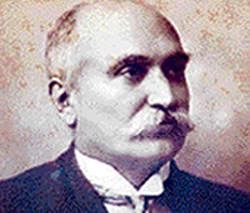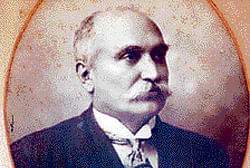
Although generations of people have enthusiastically delved into the history of our land, archaeological research in the erstwhile Mysore State formally began with the establishment of the Department of Archaeological Research a little over 125 years ago.
And undoubtedly, the granddaddy of archaeological research in Karnataka is the Department’s first Director, B L Rice.
Benjamin Lewis Rice was born in Bangalore in July 1837 to academically inclined missionary parents. Benjamin Holt Rice, Lewis Rice’s father, came to India in 1837 and took just seven months to master Kannada, going on to even write books in the language.
When the school he was associated with found it difficult to procure good textbooks, Rev. Rice went ahead and wrote them, including books on arithmetic, geography, history and the Bible.
Growing up in such an atmosphere, it is perhaps not too surprising that young Lewis Rice’s resume reads like an almost impossible chronicle of achievements. He went to England to study and returned with a BA in 1860, whereupon he was appointed principal of Bangalore High School, the precursor to Central College.
Five years later, he was Inspector of Schools for Mysore and Coorg, and Director of Public Instruction in Mysore and Coorg soon after (1868). Later, he was also made Chief Census Officer (1881) and Secretary, Education Department (1883).
Rice distinguished himself in these posts. One of his greatest achievements was the ‘hobli school system’ that he introduced during his tenure as Director of Public Instruction, when he was just 31 years old.
This attempt to take education to people’s doorsteps envisaged free village schools administered by local bodies and paid for by land revenues. Unfortunately, though initially popular, the lack of trained teachers doomed this educational reform to failure.
Master of languages
During his early years of education, Rice began acquiring fluency in a number of languages. A year after becoming principal of Bangalore High School, he took the higher secondary examination in Kannada. He passed, of course, and followed that up with an examination in Hindi four years later. Meanwhile, he also learnt Sanskrit. Later, over the course of his epigraphical work, he also learned Tamil and Grantha, an ancient script used to write Tamil and Sanskrit.
But he had a special love for the language of the land where he was born. Historian A Sundara writes of an incident that occurred eighteen years after Rice had retired and moved to England.
At an exhibition held in London in 1924, Rice met a guide in one of the pavilions who was a Kannadiga. After exchanging pleasantries, Rice burst out: “Ayya, Kannadadalli matanadonave? Muddada Kannada kiviya mele biddu thumba dinagaladuvu.” (Shall we speak in Kannada? It is many days since I heard that sweet language.”) While he was Inspector of Schools, Rice also set the Kannada question papers for Bangalore High School students appearing for the Fine Arts examinations. He appears to have been a hard taskmaster, for some of his reports note with asperity the poor standard of Kannada in some of the students!
Tryst with epigraphy
It was during his stint in education that Rice’s interest in history was piqued. While on tours inspecting schools, Rice came across many inscriptions written on stone. Around the same time, the then chief commissioner, LB Bowring, commissioned someone to take photographs of about 150 inscriptions, mostly from northern Karnataka. Rice’s tryst with epigraphy began in 1872 when these photographs were given to him to translate at his leisure.
Rice fell to the task with gusto. Most of the inscriptions were in Hale Kannada (Old Kannada) and so had archaic letter forms which neither Rice nor any scholars nor priests knew. But with perseverance and the aid of a clever but reluctant Sanskrit and Kannada scholar, Rice finally managed to decipher the inscriptions.
In 1879, he brought out the volume Mysore Inscriptions, which contained translations of these inscriptions. Several more volumes on inscriptions followed, including books on the inscriptions of Shravanabelagola, and his magnum opus, Epigraphia Carnatica – twelve hefty tomes on inscriptions in various parts of Karnataka. Overall, Rice translated almost 9,000 inscriptions from all over Karnataka.
Rice’s work was the first such intensive and systematic survey of inscriptions in India. With not just translations, but also complete transliterations and transcriptions of inscriptions, the Epigraphia volumes are usually the most frequently-consulted books on many a scholar’s bookshelf.
‘Magnum opuses’
Rice’s work on inscriptions slowed down because the government, impressed with his thorough and methodical manner of gathering information, also gave him the task of preparing Gazetteers for the State and for every district. Hence came about Rice’s other magnum opus, the Mysore Gazetteer, the first of which was published in 1876, the second in 1897. Like Epigraphia Carnatica, Lewis Rice’s Gazetteers are still the go-to books for general and historical information about most cities, towns and districts in Coorg and erstwhile Mysore.
The comprehensive information in Rice’s books was based in part on detailed questionnaires that Rice sent to Deputy Commissioners and taluk officials, and partly on his archaeological research tours around the state.
In 1885, for example, the year he was made part-time Director of Archaeological Research, he spent 215 days scouring 654 towns and villages for historical relics. The next year, he visited four more taluks, then nine more taluks the following year, and nine more after that…and so on it went. These archaeological tours on his faithful white pony, often to remote areas, seem to have been adventures in themselves: In one of his reports, for example, Rice notes with typical British understatement, “Some danger was encountered from a large cobra.” Rice was married to Mary Sophia Garrett, the child of another missionary in Bangalore. They had ten children and lived in a large, beautiful bungalow that he built on Sankey Road, which today houses an upmarket boutique.
Remembrance of things past
Rice’s granddaughter, Sheila Bevan, writes fondly of how, returning from his innumerable tours, Rice sometimes jokingly enquired of his wife, “And how many children do we have now, Mary?”
In 1906, Rice retired and moved with his wife to England. But he continued working on revisions of some of his books. He also set and marked the examinations in Kannada literature for students of London University. In April 1927, he wrote to his friend and protégé, the distinguished archaeologist R Narasimhachar, “Remember me to those who still enquire about me. My love for Mysore is unending.” Lewis Rice is indeed well-remembered and deservedly eulogised by historians as shasanapitamaha – the grandsire of inscriptions.
RICE ROUTE
*Douglas Rice, a retired English teacher and his family visited Mysore in November last year, and participated in an interaction organised by the Department of Ancient History and Archaeology, University of Mysore, at Manasagangothri.
* Speaking at the interaction, Douglas recalled that his grandfather H D Lewis was a civil engineer in the erstwhile Mysore State. Douglas Rice is the great grandson of B L Rice.
* H D Lewis, according to Douglas, lived on the first floor of a bungalow which is now known as Hotel Metropole in Mysore.
